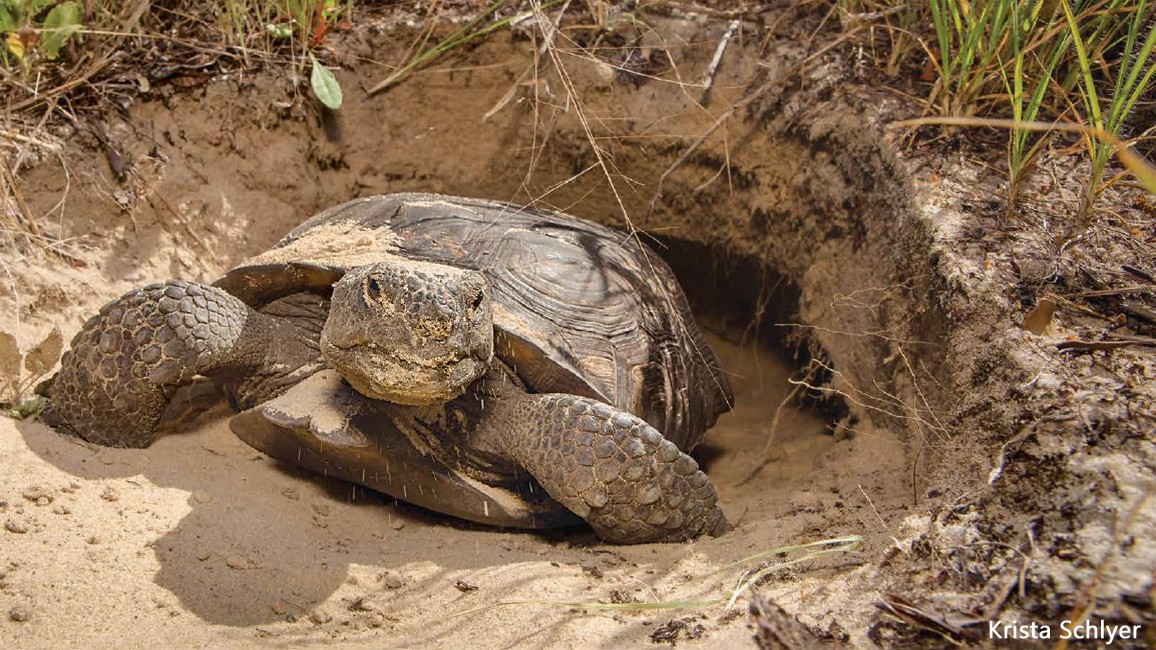
Gopher Tortoises
By Ellen LambethWherever this slow-going reptile lives, you’ll find a wild community full of other “happy campers,” too!

The scaly fellow above is a gopher tortoise. It’s basking in the sun at the entrance to its burrow. Maybe soon, it will warm up enough to plod away in search of some tasty leaves, flowers, and fruits to eat.
Gopher tortoises live in sandy-soil long-leaf pine forests of the southeastern United States (see map). They once were so plentiful that people collected them for food. Later, many were caught as pets. Eventually, they lost much of their living space wherever the forests were cleared and the land was built on. As a result, there aren’t so many gopher tortoises left. Now people are working hard to protect them.
A gopher tortoise’s main claim to fame is as master digger! With its strong, spade-like front feet, it digs a long, deep burrow, just wide enough to turn around in. The tortoise spends most of its time in this climate-controlled” space. During the hot, dry summer, the burrow stays cool and moist. In the chilly winter, it feels warmer down there. At night, it’s a safe place to hide and rest. And best of all, a gopher tortoise shares its space with others—with many others, in fact!
ONE GOPHER TORTOISE BURROW IN FLORIDA WAS MEASURED AT 65 FEET LONG AND 26 FEET DEEP!

WELCOME!
Believe it or not, more than 350 different kinds of animals may share a gopher tortoise’s burrow. Most, such as lizards and toads, slip in on occasion for some of the same reasons the tortoise does. Some, such as spiders and snakes, go in to find food. And some, such as the gopher cricket, live nowhere else on Earth!
The gopher tortoise doesn’t seem to mind any of these houseguests. They just get out of the way as the tortoise comes and goes. When a gopher tortoise leaves a burrow for good, animals such as foxes or burrowing owls may take it over for raising young.
As the tortoise digs, it sweeps up rich soil from below—good for sprouting seeds. This soil forms a sandy apron at the front of the burrow.
The burrow entrance is easy to recognize, with its half-circle shape.
This six-lined racerunner might seek shelter in a tortoise burrow. It might even lay eggs in the warm sand outside the burrow’s entrance.
Small mammals such as this eastern cottontail may scurry into a tortoise’s burrow to escape fire or a predator.
At the bottom of the burrow is a roomy end chamber. The tortoise spends most of its time in here.
The indigo snake is a threatened species that has already disappeared from much of its range. It often uses a tortoise burrow as its winter den.
THE GOPHER TORTOISE IS A KEYSTONE SPECIES. THAT MEANS MANY OTHER SPECIES DEPEND ON IT FOR THEIR SURVIVAL.

FIRE!
No worries: Fire is natural here in the gopher tortoise’s longleaf pine forest home. At least, it used to be. A lightning strike might start a blaze every few years. The fire would sweep through quickly, burning off grass tops and keeping too many new trees and shrubs from filling in all the open space. Meanwhile, the big, thick-barked pines were unharmed, and most animals could flee, fly, or hide out in tortoise burrows until the danger passed.
This was perfect for the gopher tortoise. Afterward, the sun would shine down through the open forest to now-bare, fertile ground. There, seeds would sprout and new plants would quickly grow. That meant fresh food for tortoises! It also meant easy footing to walk or dig through and warm sun to bask in.
Then a time came when people thought all fires were bad, and firefighters would put them out. But when a long time passes between small natural fires, the forest fills up with too much woody “fuel.” All that fuel makes any fires that do break out much bigger and more dangerous. Now people realize how important small, frequent fires are in keeping this forest healthy. To manage the forest safely, they sometimes start what’s called a prescribed or controlled burn. And gopher tortoises—along with their many roommates—are just fine with that!
The wildlife expert (above right) prepares to release a rescued gopher tortoise into an open space in the forest. Here, the tortoise will find fresh food, such as that passion flower, and a safe place to dig a new burrow.
A forest manager (bottom left photo) starts a controlled fire in tortoise habitat to keep the longleaf pine forest open and healthy.
IN FLORIDA, THESE TURTLES GET THEIR OWN OFFICIAL DAY: APRIL 10 IS GOPHER TORTOISE DAY!
















